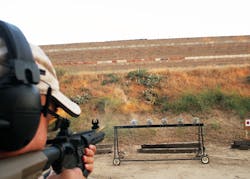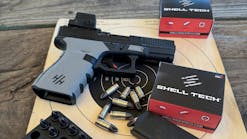Consider the cartridge
The 7.62 x 35 300 AAC Blackout (300 BLK) has gotten a lot of attention lately, especially amongst law enforcement users. We had to satisfy our curiosity about the cartridge and get a little insight about its performance.
In the most recent range adventure we fired the SIG 220-grain Elite Performance OTM (Open Tip Match) Subsonic and 220-grain and 125-Elite Performance OTM supersonic cartridges through our RF upper. We shot steel with the TNQ 300 BLK 125-grain frangible ammo.
The 300 AAC Blackout is a rifle cartridge specifically designed for the M4 carbine platform. The AAC part stands for Advanced Armament Corporation, well known for their design and manufacture of suppressors. Knowing this, most can surmise that suppressor performance was a consideration in the design of this cartridge.
Most shooters, including me, will tell you that the 300 BLK has only slightly more recoil impulse then a 5.56, given the same platform. Since converting an AR 15 from .223 to 300 BLK only requires a barrel change, it is probably the most logistically brilliant conversions in the industry. Think about it: The 300 BLK conversion uses the same bolt, magazine and manual of arms. Being able to use the same magazine at the same capacity is big. For agencies considering the switch, not needing new magazines means one less purchase order.
What’s the trade-off? First, the 300 BLK has significantly more close quarter effectiveness then the 5.56. Although the numbers suggest a virtual tie between the 5.56 and 300 BLK at close quarters (1300 versus 1350 foot pounds of energy), the larger frontal area of a 30 caliber bullet seems to give the user 7.6 2X 39 performance.
The versatility is definitely a factor. Using a simple magazine change, the 300 BLK shooter can go from a subsonic load which squeezes out suppressor efficiency very well, to a supersonic load that has downrange performance the 5.5 6X 39 cannot approach. There are some specialty rounds designed for the 300 BLK that can punch through barriers that reject some battle rifle projectiles. Before we dismiss the versatility of the 300 BLK as “no big deal”, bear in mind that with many other cartridges, this type of swapping either requires a gas adjustment or some kind of hardware change.
Most of us are repeating the mantra that the 300 BLK has the same effectiveness at 700 meters that the 5.56 has at 500 meters. This is true. Most users also report predictable accuracy at further ranges than the 5.56. Supersonic loads use bullets around 125 grains and subsonic loads are around 220 grains. A .223 bullet runs 52-70 grains, with the most common types under 62 grains. The heavier bullets of the 300 BLK buck wind better downrange than the 55 grain .223 bullets.
The similarities in recoil impulse between the .223 and 300 BLK is promising. Shooters can maintain a flat muzzle with the 300 BLK in CQB.
Radical Firearms of Stafford, Texas, is a manufacturer (as opposed to a firearms assembler), who has a full line of pistols, rifles, shotguns, and machine guns. They have their own in-house line of suppressors. Originally a small shop, they began to manufacture their parts when the ones they purchased did not meet their quality demands.
I like Radical Firearms for their quality build at good prices, but I especially like the fact they manufacture their own build parts. My 300 BLK Upper has the RF Round Rail free float handguard with a forged receiver. The handguard is comfortable to hold, yet allows for Magpul MOE attachments and rail sections. The barrel is a 16-inch 1/8 rate of twist, Melonite HBAR, which give years of hard use.
The 1/8 rate of twist is probably not a good choice for 200 plus grain bullets, and the SIG Subsonic performance didn’t compare with the SIG Supersonic ammo. It did, however, demonstrate the low flash that is another desirable characteristic of cartridges designed for suppressed firearms. In fact, our session with the SIG Elite Performance Subsonic ammo went late into the evening. This proved to be a very low flash ammunition.
The RF 16-inch upper really gave the carbine a great balance, aiding in rapid transition from target to target. We used Meprolight’s FBS (Front Backup Sight) and RBS (Rear Backup Sight) with embedded tritium. These were designed as auxiliary sights and they performed perfectly for this test.
What stabilizes the SIG 300 BLK Subsonic cartridges best? Why the SIG SAUER MCX, of course.
The SIG Supersonic 125 grain Elite Performance Cartridges were capable of tiny groups in this upper. Using this combination, it was easy to engage targets with controlled pairs.
We used Team Never Quit Ammunition (TNQ) frangible cartridges on steel.
Most Americans will recognize retired Navy Seal Marcus Luttrell’s name, the Lone Survivor of Operation Redwing. Team Never Quit was founded by Luttrell to emulate perseverance over adversity. They have a team of speakers, a line of apparel, and a line of ammunition for training and self-defense.
If I hadn’t loaded the magazines myself, I would have thought I was shooting a 5.56. It’s just as quick on the steel plates, except they go down quicker.
The Team Never Quit frangible ammunition designed to allow close training on steel. There are some who consider using frangible ammunition in specific environments, like for Air Marshalling on a plane, but these are limited applications. Frangible ammunition is generally used to give the same performance as duty ammo, without backsplash, allowing users to “train like you fight”.
Frangible ammunition is made primarily of compressed powdered metal. It has all of the qualities of a FMJ type bullet until it strikes something harder than the powdered metal. When it does, it disintegrates. The TNQ 300 BLK ammo had about the same characteristics and “feel” as the SIG 300 BLK Supersonic ammunition.
Similar performance and characteristics allows a seamless transition from training to duty. Although there are plenty of training methods for producing quick shooting responses with a carbine, nothing produces more positive reinforcement like shooting frangible on steel. That is, the ringing of steel when shooting is an immediate indication of a hit. The shooter can improve the cadence of the delivery by this type of practice.
Some agencies use lead bullets, which certainly increase the longevity of the steel targets, but lead can splash back and harm the shooter and those around him. Frangible ammo has about the same effect as throwing ice at the steel targets. It breaks up into powder.
Using TNQ 300 BLK ammo, we were able to shoot at nearly point blank. We had camera equipment and several observers standing next to the shooter. If anyone knows me, they would know that I don’t put my lenses at risk. I trusted the safety of the frangible bullets on steel.
The 300 BLK cartridge is more than impressive. Our initial tests suggest that this is the Wave of the future for Law Enforcement cartridges in this platform.
Lindsey Bertomen

Officer Lindsey Bertomen (ret.), Contributing Editor
Lindsey Bertomen is a retired police officer and retired military small arms trainer. He teaches criminal justice at Hartnell College in Salinas, California, where serves as a POST administrator and firearms instructor. He also teaches civilian firearms classes, enjoys fly fishing, martial arts, and mountain biking. His articles have appeared in print and online for over two decades.



